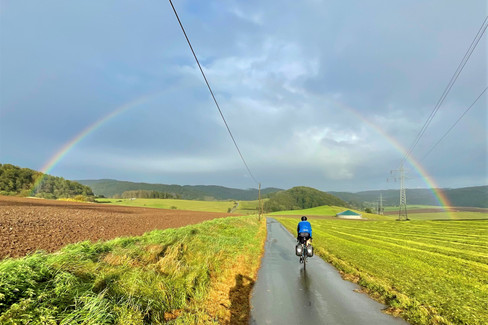Bikepacking with two cameras in Sauerland
- Erwin Hartenberg

- Oct 3, 2021
- 4 min read
I was a bit anxious about bikepacking at the end of September in the Sauerland region in the middle of Germany, given that the weather could be, well.......anything really. And we did get our fair share of weather varieties the region has to offer in the five days we spent peddling around the area. The timing of this trip was the result of an ad-hoc change I had to make. My wife and I were supposed to go to the US for three weeks in September but we had to change plans as it was not possible for EU citizens to travel in to the US due to Covid-19, vaccinated or not. So alternative plans had to be made. My wife and I ended up spending two wonderful weeks in Sardinia and I used the third week for something I've been wanting to do for a while: bikepacking. I did not want to have just my phone for taking photos, even though storage space on a bikepacking trip is very precious. I ended up taking two cameras and I was quite happy with the setup. More on that below.

I am a cyclist, I think I would call it my main sport by now. But I've never done a trip where you take everything with you on the bike. So when the US trip fell through, it seemed like a great opportunity to try this out. My brother and a friend signed up to come along. We chose the Sauerland region in Germany as our destination and would drive there to do a circle in 5 stages to take us back to where we parked our car. Unfortunately, due to bike and other issues, it was down to my brother and me after day one as our friend had to bail out.

The Sauerland region is situated mostly in the North Rhine-Westphalia 'Land' in Germany and is enclosed by the Ruhr river in the north and Sieg river in the south. The terrain is hilly and carved by loads of tributaries of the main rivers. It is reasonably high with the Langenberg reaching 843 meters. The climbs are a little less steep compared to regions like the Ardennes in Belgium or the Eifel in Germany. This makes it perfect for bikepacking as the slightly lower gradients are kinder on the legs given the extra kilos you have to take up with you in your bags. We ended up doing about about 1500 altitude meters every day and while the extra weight was noticeable, the climbs were enjoyable.


The roads are mostly in excellent condition, something you appreciate even more when your bike is heavier than usual. Smaller villages are dotted around the landscape which has a small scale manufacturing history, particularly involving timber and steel. This leaves plenty of space for the landscape to shine. The fall colors were only starting to show themselves so the main hue of the forests was still dark green. In contrast to the light green meadows where the cows are trying to catch a glimpse of the sparse rays of sunshine.

As mentioned, the weather was a mixed bag. We spent quite some hours under a grey cover with the sky opening up every now and then. The sun did show itself more often on one of the days which immediately upgraded the experience. We also had one day with plenty of rain, putting the waterproof bags to the test. Fortunately, all bags performed admirably and everything stayed dry. It is a comforting feeling to have, when you are making your way through the rain and puddles that you know that you have dry clothes waiting for you at the end of the day.

For my camera setup, I read up on the options and I ended up buying a camera bag for my bike from a small Polish shop called Dyed In The Wool. The bags are made to order and you can choose different levels of waterproofing, I picked the middle option. The company stresses that the bag is not 100% waterproof and when it really rains cats and dogs, valuables should be kept in a drybag. During the worst rainfall, I did put my cameras in a drybag but it turned out not to be necessary as the camera bag stayed dry in the main compartment.


I did not want to spend a lot of time switching lenses so I took my Sony RX1RII with its 35mm F2 lens, and my Sony A7RIII with the Batis 135mm F2.8 aperture. This combo worked well and allowed for more contextual shots paired with the tele perspective of the Batis. The 135mm perspective is great for roads and I am happy with how some of the shots turned out.

We ended up doing around 400km which allowed for getting a good impression of this region. I think I can safely say that I will return to the Sauerland to explore more of its roads.
Here are a few more photos from the trip.































Comments